Space Plasma Distribution Effect of Short-Circuit Arc on Generation of Secondary Arc
Abstract
:1. Introduction
2. Arc Numerical Simulation Theory Model
2.1. Coefficient Partial Differential Equation and Classical Drift-Diffusion Model
2.2. Simplified Model of the Arc Discharge Process
3. Finite Element Simulation Model of Arc
3.1. Model Definition and Mesh Generation
3.2. Boundary Conditions Setting
3.2.1. Reaction Coefficient of Air Discharge Equation
3.2.2. Numerical Simulation of Short-Circuit Arc
3.2.3. Initial Conditions and Boundary Conditions
4. Space Plasma Distribution Effect of Short-Circuit Arc on Generation of Secondary Arc
4.1. Electric Field Distribution
4.2. Concentration Distribution of Electrons, Negative Ions and Positive Ions
4.3. The Generation, Diffusion and Arc Extinguishing Process of Short-Circuited Arc
4.4. Time Dependence of Ionic Reaction during Arc Discharge
4.5. Gradient Distribution of Spatial Ions Concentration
5. Conclusions
- The time-space analysis results of positive ion, negative ion and electron concentrations indicate that the short-circuit arc discharge process at the initial stage includes two processes: the corona discharge and arc discharge caused by short-circuit, and that the duration of the former is very short. During the arc discharge process, the electron density at the arc striking wire increases first and then decreases due to the anode electrode adsorption of electrons and the Joule heating effect of high current caused by short-circuit arc, which is different from the general streamer discharge.
- The concentration distribution curves of the positive ions and negative ions are the same, but there are still slight differences due to their difference of diffusion, convection and adsorption coefficient. When the ion reaction approaches to the end of the simulation time, the ion concentration is higher than the initial level, which proves that the space ion concentration is increased due to the short-circuit discharge, providing the necessary environmental conditions for the generation of secondary arc.
- The diffusion effect of space ions in the initial stage of discharge is almost zero. The ion diffusion direction was radial in the peak discharge phase, while axial in the late discharge. The electric field intensity in space has an S-shaped upward trend during discharge. Both ends are strongly influenced by the electrode, while the middle region is mainly influenced by the particle reaction. The time relationship of the ion source generated by the neutralization reaction and by the short-circuit arc discharge are basically the same, and the rate of neutralization reaction is lowest near the electrode.
Acknowledgments
Author Contributions
Conflicts of Interest
References
- Dias, O.; Magrin, F.; Tavares, M.C. Comparison of secondary arcs for reclosing applications. IEEE Trans. Dielectr. Electr. Insul. 2017, 24, 1592–1599. [Google Scholar] [CrossRef]
- Sun, Q.; Yin, J.; Wang, F.; Yan, J.; Li, Q.; Chen, S. Influence of grading capacitor of multiple-break circuit breaker on the extinction of secondary arc—A new method for reducing dead time. IET Gener. Transm. Distrib. 2017, 11, 1954–1965. [Google Scholar] [CrossRef]
- Dudurych, M.; Gallagher, T.J.; Rosolowski, E. Arc effect on single-phase reclosing time of a UHV power transmission line. IEEE Trans. Power Deliv. 2004, 19, 854–860. [Google Scholar] [CrossRef]
- Tsuboi, T.; Takami, J.; Okabe, S.; Aoki, K.; Yamagata, Y. Study on a field data of secondary arc extinction time for large-sized transmission lines. IEEE Trans. Dielectr. Electr. Insul. 2013, 20, 2277–2286. [Google Scholar] [CrossRef]
- Tavares, M.C.; Talaisys, J.; Camara, A. Voltage harmonic content of long artificially generated electrical arc in out-door experiment at 500 kV towers. IEEE Trans. Dielectr. Electr. Insul. 2014, 29, 1005–1014. [Google Scholar] [CrossRef]
- Li, Q.; Cong, H.; Sun, Q.; Xing, J.; Chen, Q. Characteristics of secondary AC arc column motion near power transmission line insulator string. IEEE Trans. Power Deliv. 2014, 29, 2324–2331. [Google Scholar] [CrossRef]
- Gu, S.; He, J.; Zeng, R.; Zhang, B.; Xu, G. Motion characteristics of long ac arcs in atmospheric air. Appl. Phys. Lett. 2007, 90, 051501. [Google Scholar] [CrossRef]
- Cong, H.; Li, Q.; Xing, J.; Siew, W.H. Modeling study of the secondary arc with stochastic initial positions caused by the primary arc. IEEE Trans. Plasma Sci. 2015, 43, 2046–2053. [Google Scholar] [CrossRef]
- Gu, S.; He, J.; Zhang, B.; Xu, G.; Han, S. Movement simulation of long electric arc along the surface of insulator string in free air. IEEE Trans. Magn. 2006, 42, 1359–1362. [Google Scholar]
- Horinouchi, K.; Nakayama, Y.; Hidaka, M.; Sasao, H. A method of simulating magnetically driven arcs. IEEE Trans. Power Deliv. 1997, 12, 213–218. [Google Scholar] [CrossRef]
- Terzija, V.V.; Koglin, H.J. On the modeling of long arc in still air and arc resistance calculation. IEEE Trans. Power Deliv. 2004, 19, 1012–1017. [Google Scholar] [CrossRef]
- Cong, H.; Li, Q.; Xing, J.; Siew, W.H. Simulation model of secondary arc for long-distance transmission lines with multi-field coupling dynamics. Int. J. Appl. Electromagn. 2015, 48, 423–436. [Google Scholar] [CrossRef]
- Davies, A.J.; Davies, C.S.; Evans, C.J. Computer simulation of rapidly developing gaseous discharges. Proc. Inst. Electr. Eng. 1971, 118, 816–823. [Google Scholar] [CrossRef]
- Georghiou, G.E.; Papadakis, A.P.; Morrow, R.; Metaxas, A.C. Numerical modelling of atmospheric pressure gas discharges leading to plasma production. J. Phys. D Appl. Phys. 2005, 38, R303–R328. [Google Scholar] [CrossRef]
- Sattari, P.; Castle, G.S.P.; Adamiak, K. Numerical simulation of trichel pulses in a negative corona discharge in air. IEEE Trans. Ind. Appl. 2011, 47, 1935–1943. [Google Scholar] [CrossRef]
- Sun, H.; Lu, B.; Wang, M.; Guo, Q.; Feng, Q. The role of photoionization in negative corona discharge: The influences of temperature, humidity, and air pressure on a corona. Phys. Plasmas 2017, 24, 103506. [Google Scholar] [CrossRef]
- Zhang, J.; Wang, Y.; Wang, D. Numerical study on mode transition characteristics in atmospheric-pressure helium pulsed discharges with pin-plane electrode. IEEE Trans. Plasma Sci. 2018, 1, 19–24. [Google Scholar] [CrossRef]
- Georghiou, G.E.; Morrow, R.; Metaxas, A.C. Two-dimensional simulation of streamers using the FEM-FCT algorithm. J. Phys. D Appl. Phys. 2000, 33, L27. [Google Scholar] [CrossRef]
- Paria, S.; Castle, G.S.P.; Adamiak, K. FEM–FCT-based dynamic simulation of corona discharge in point–plane configuration. IEEE Trans. Ind. Appl. 2010, 46, 1699–1706. [Google Scholar]
- Li, X.; Lu, X.; Li, B.; Zheng, G.; Li, L.; Geng, Z.; Shan, C.; Lin, X. Research on dielectric characteristics of SF6/N2 gas mixtures based on FEM-FCT. In Proceedings of the China International Conference on Electricity Distribution, Xi’an, China, 10–13 August 2016. [Google Scholar]
- Lin, X.; Zhang, J.; Li, X.; Xu, J.; Geng, Z.; Li, L.; Chen, H. Numerical calculation and experimental study on the insulation characteristics of SF6-N2 and SF6-CF4 gas mixtures. In Proceedings of the 4th International Conference on Electric Power Equipment-Switching Technology, Xi’an, China, 23–25 October 2017. [Google Scholar]
- Komuro, A.; Ono, R.; Oda, T. Two-dimensional simulation of streamer discharge including the vibrationally excited molecules effects. In Proceedings of the IEEE Industry Applications Society Meeting, Orlando, FL, USA, 9–13 October 2011. [Google Scholar]
- Zhang, L.; Hui, J.; Meng, X.; Bian, X.; Wang, L.; Guan, Z. The simulation of streamer dynamics in the air gap. In Proceedings of the IEEE Conference on Electrical Insulation & Dielectric Phenomena, Cancun, Mexico, 16–19 October 2011. [Google Scholar]
- Wu, F.; Liao, R.; Yang, L.; Liu, X.; Wang, K.; Zhou, Z. Numerical simulation of Trichel pulse characteristics in bar-plate DC negative corona discharge. Acta Phys. Sin. 2013, 62, 348–357. [Google Scholar]
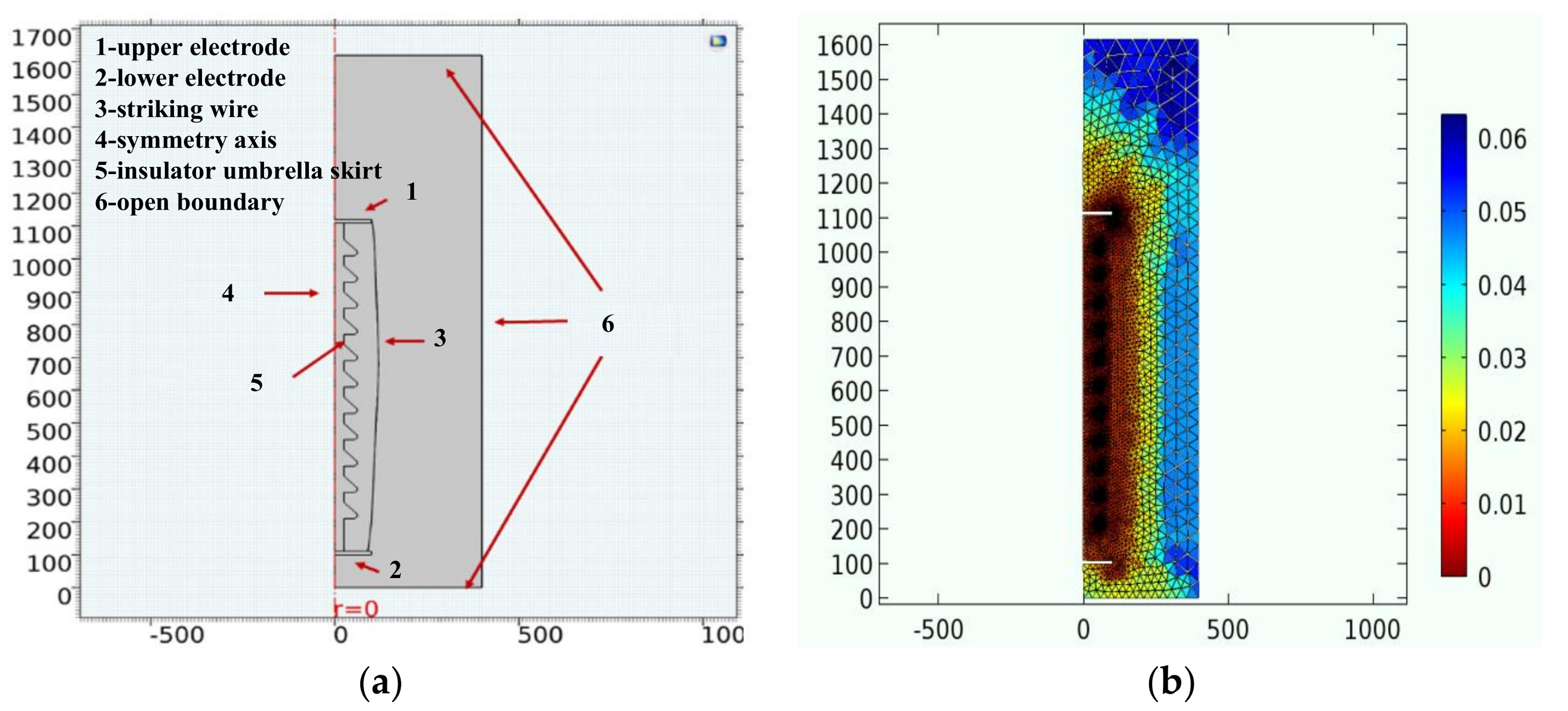
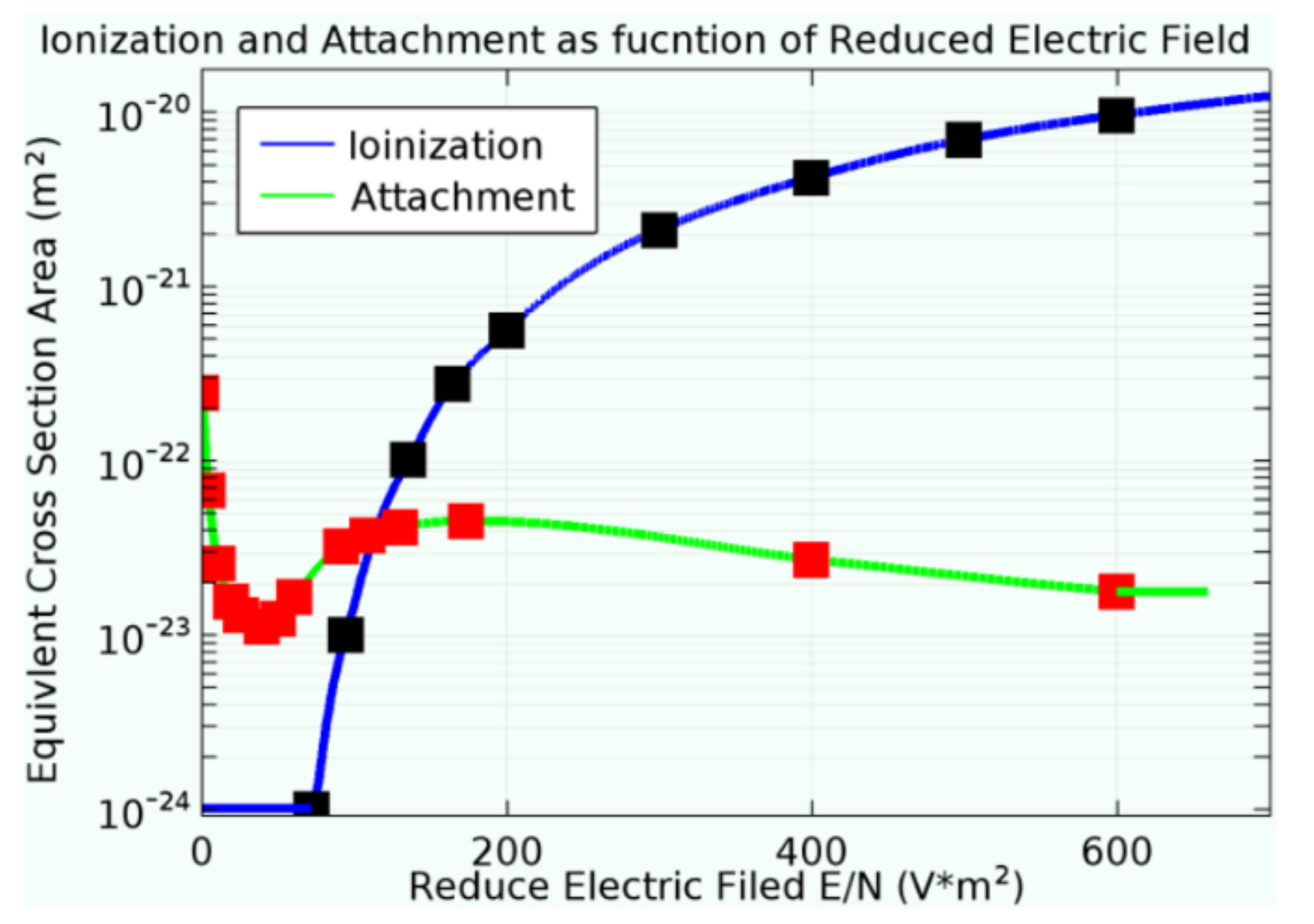
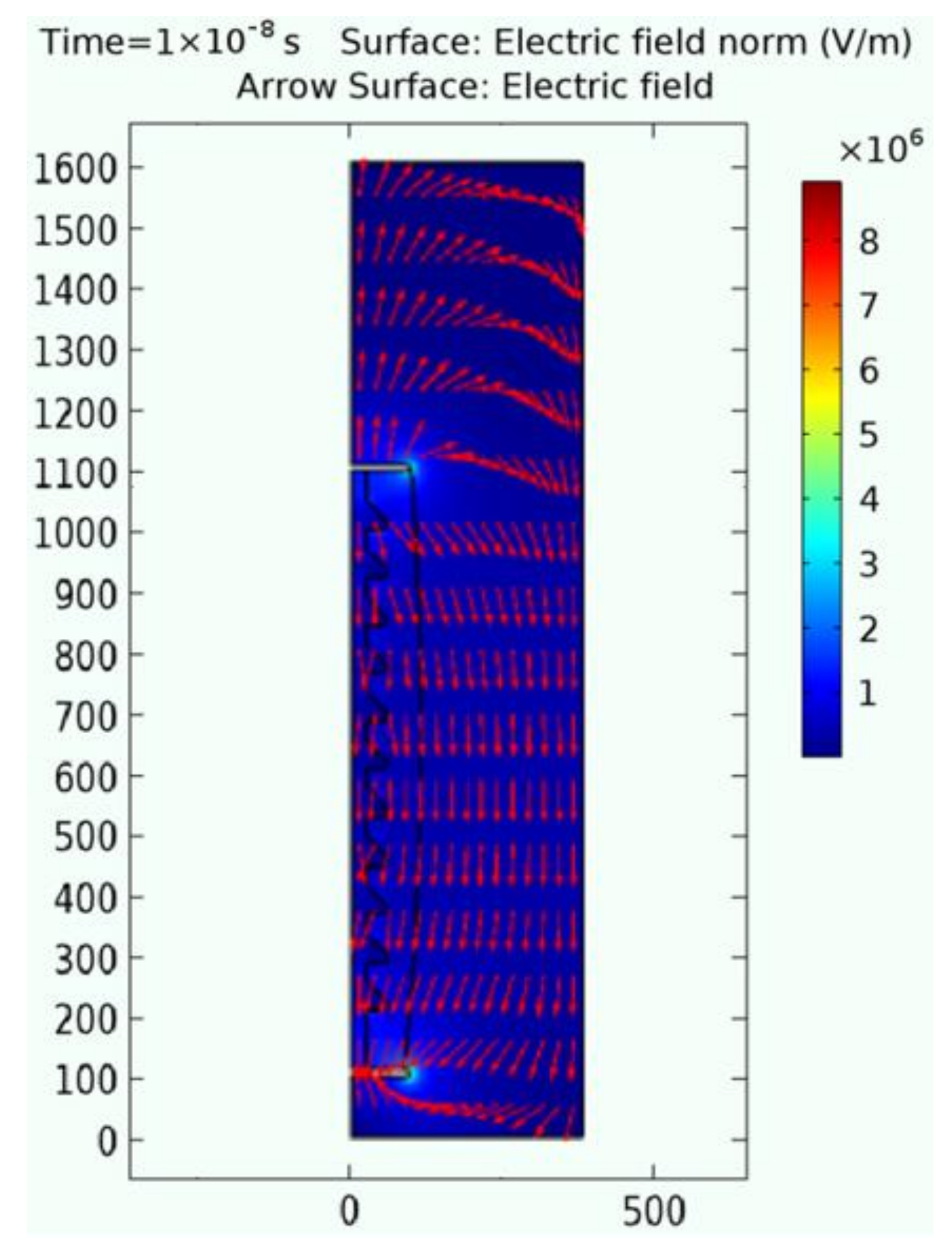
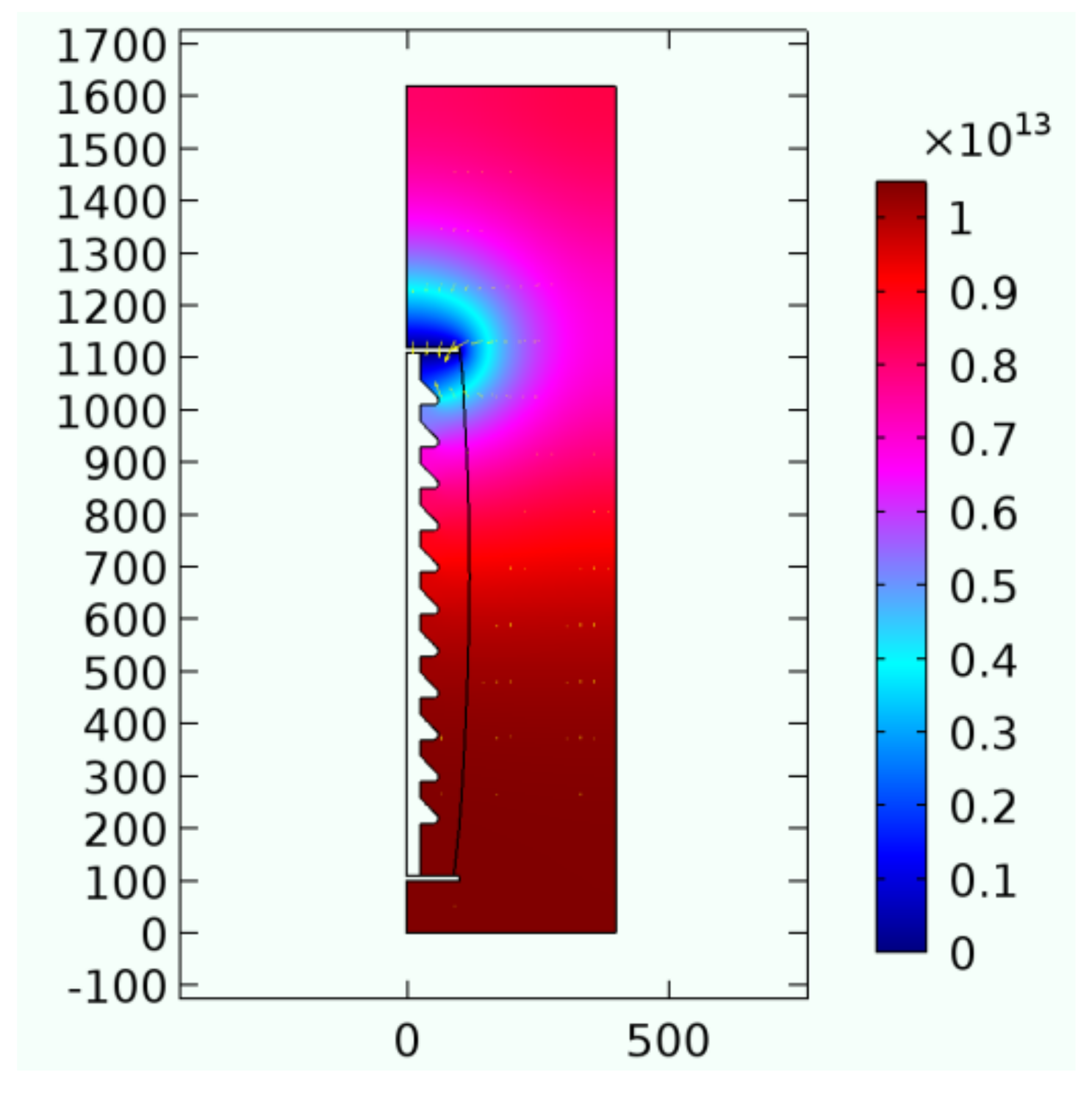
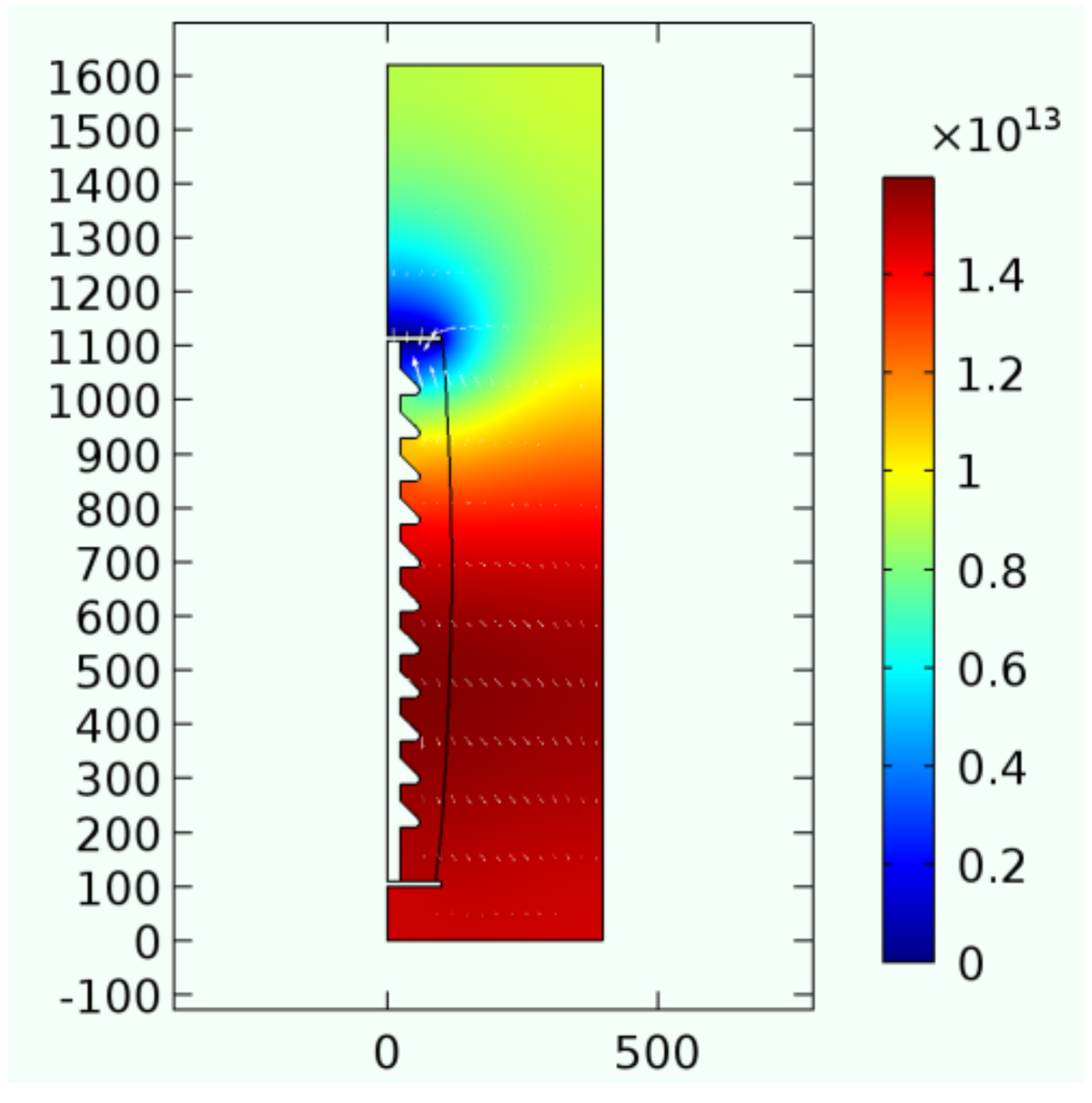
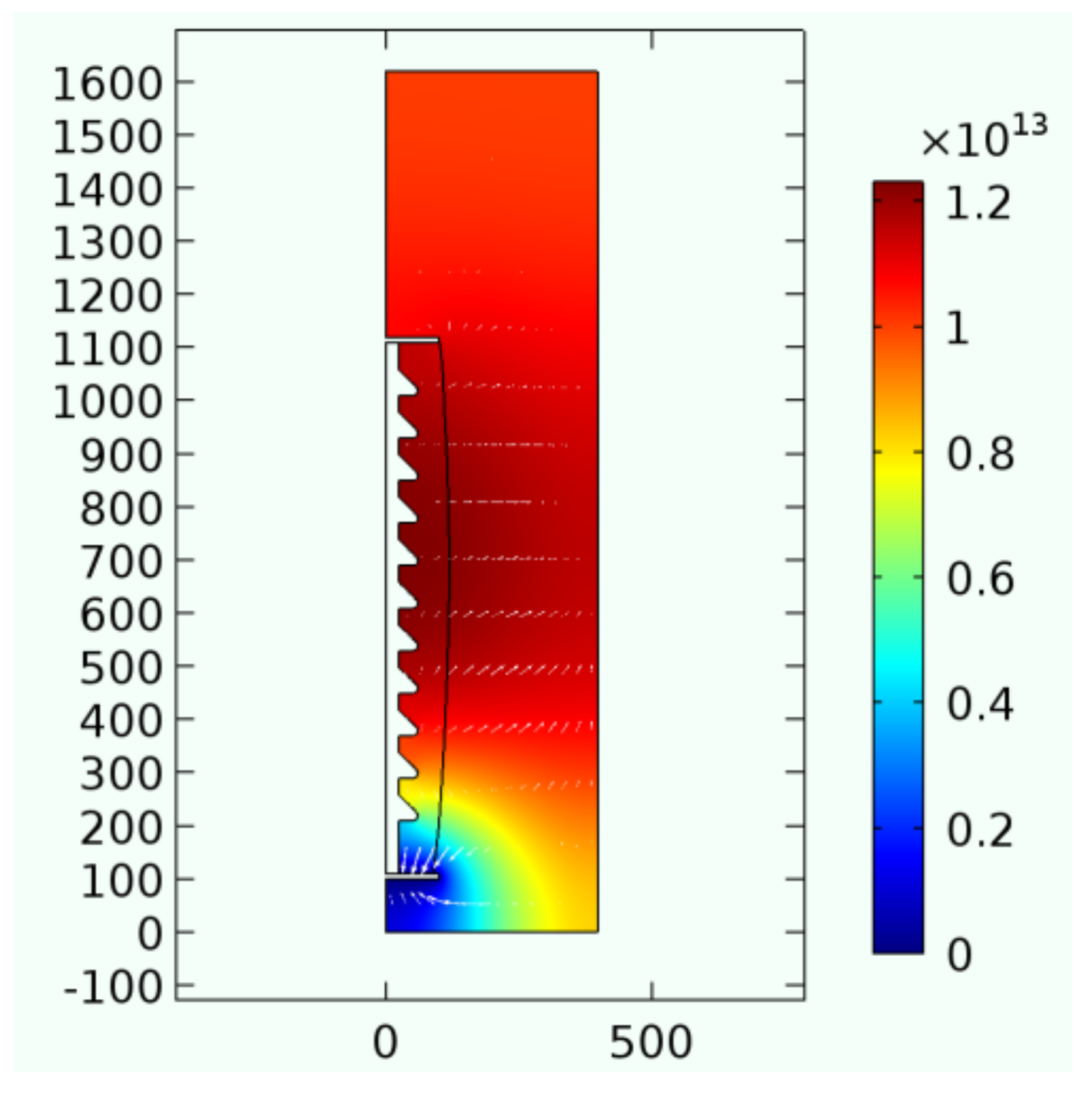

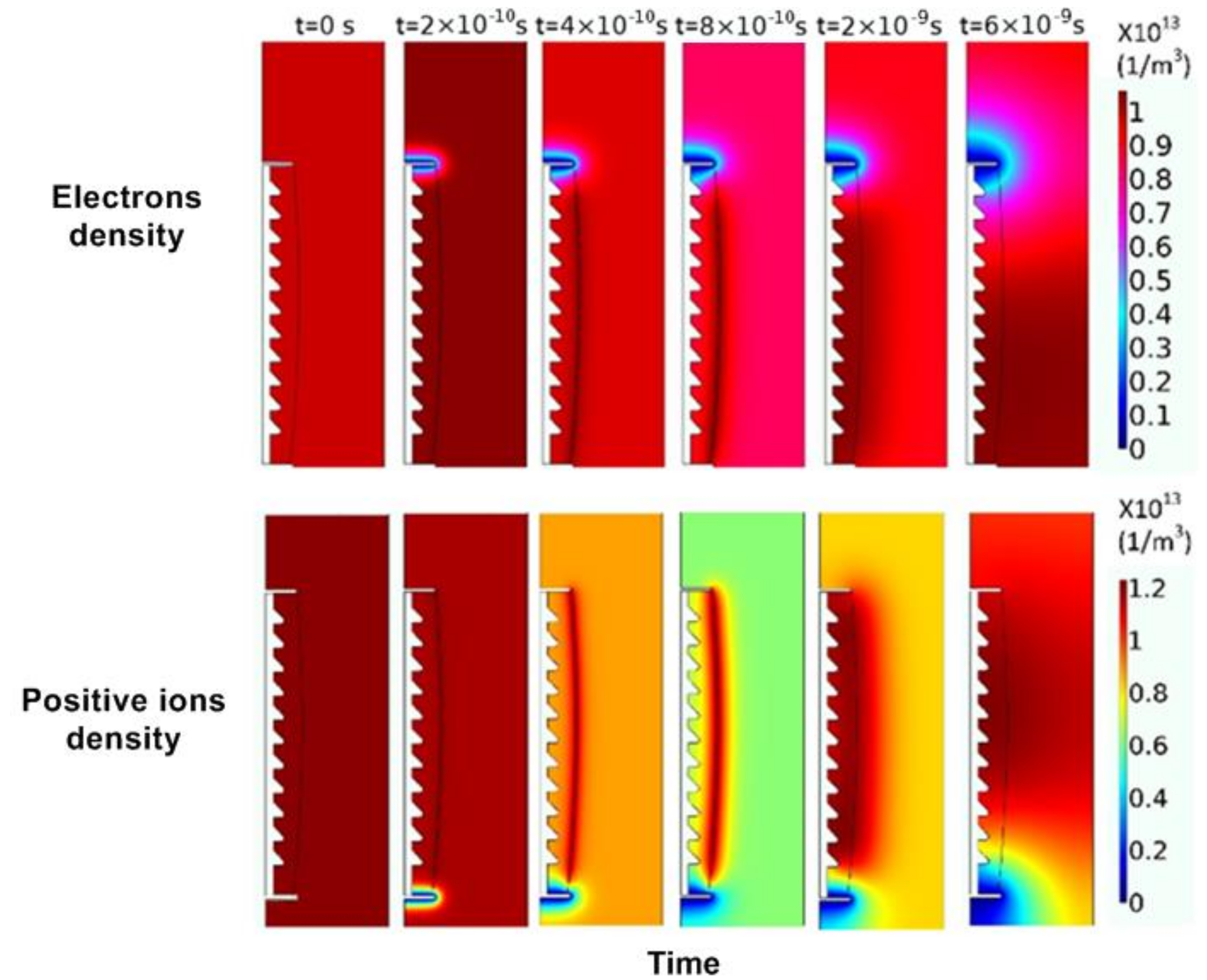
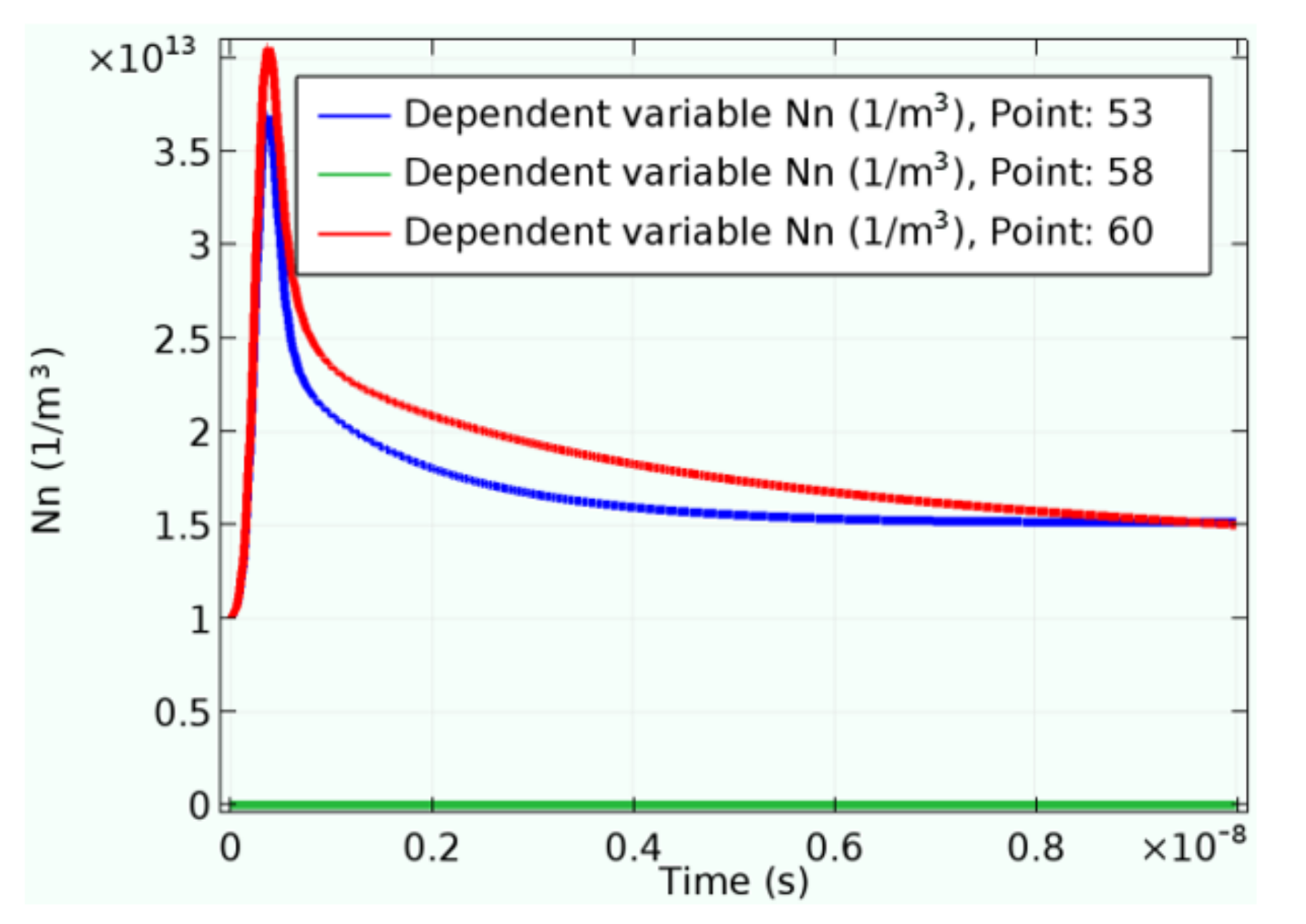
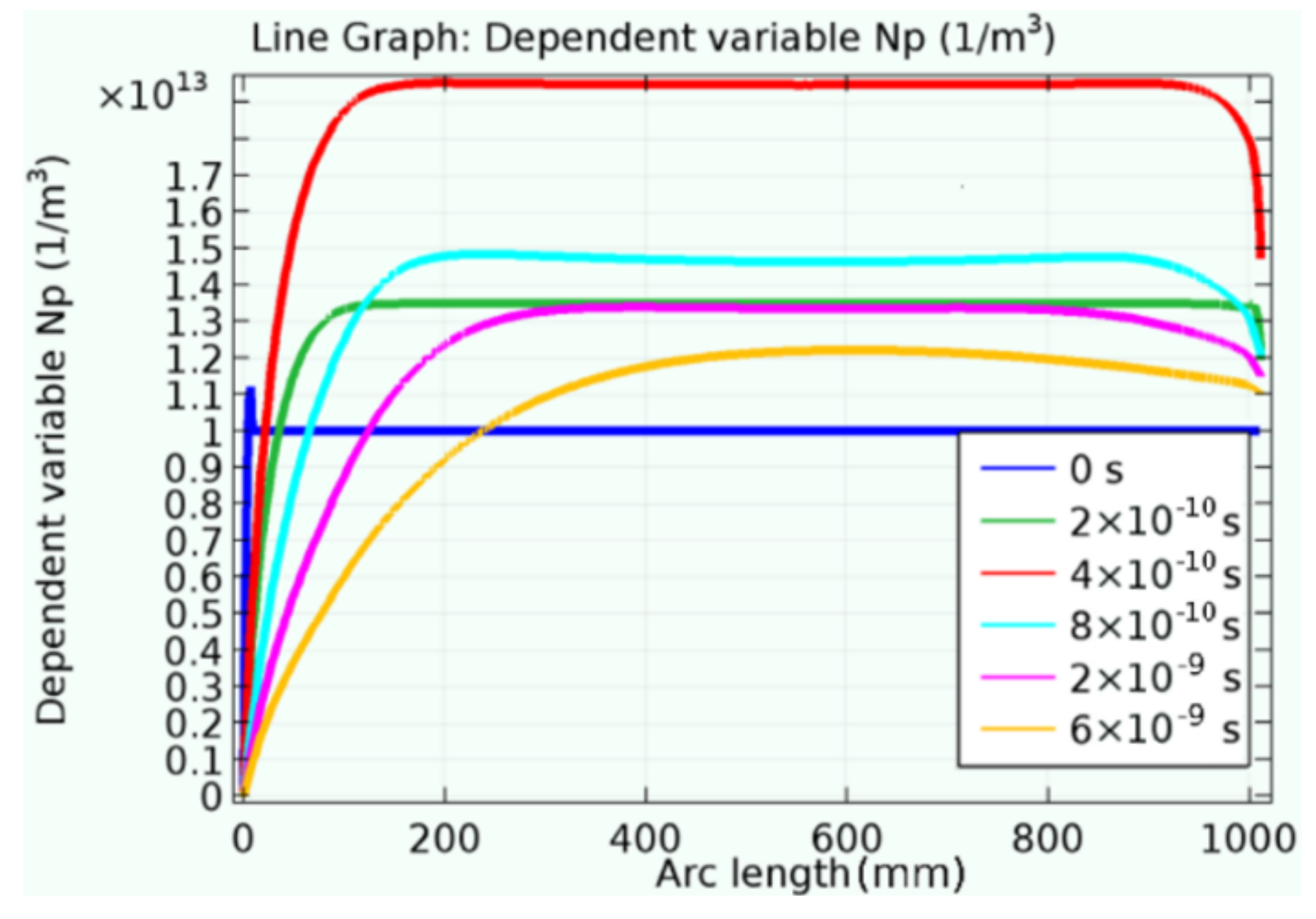

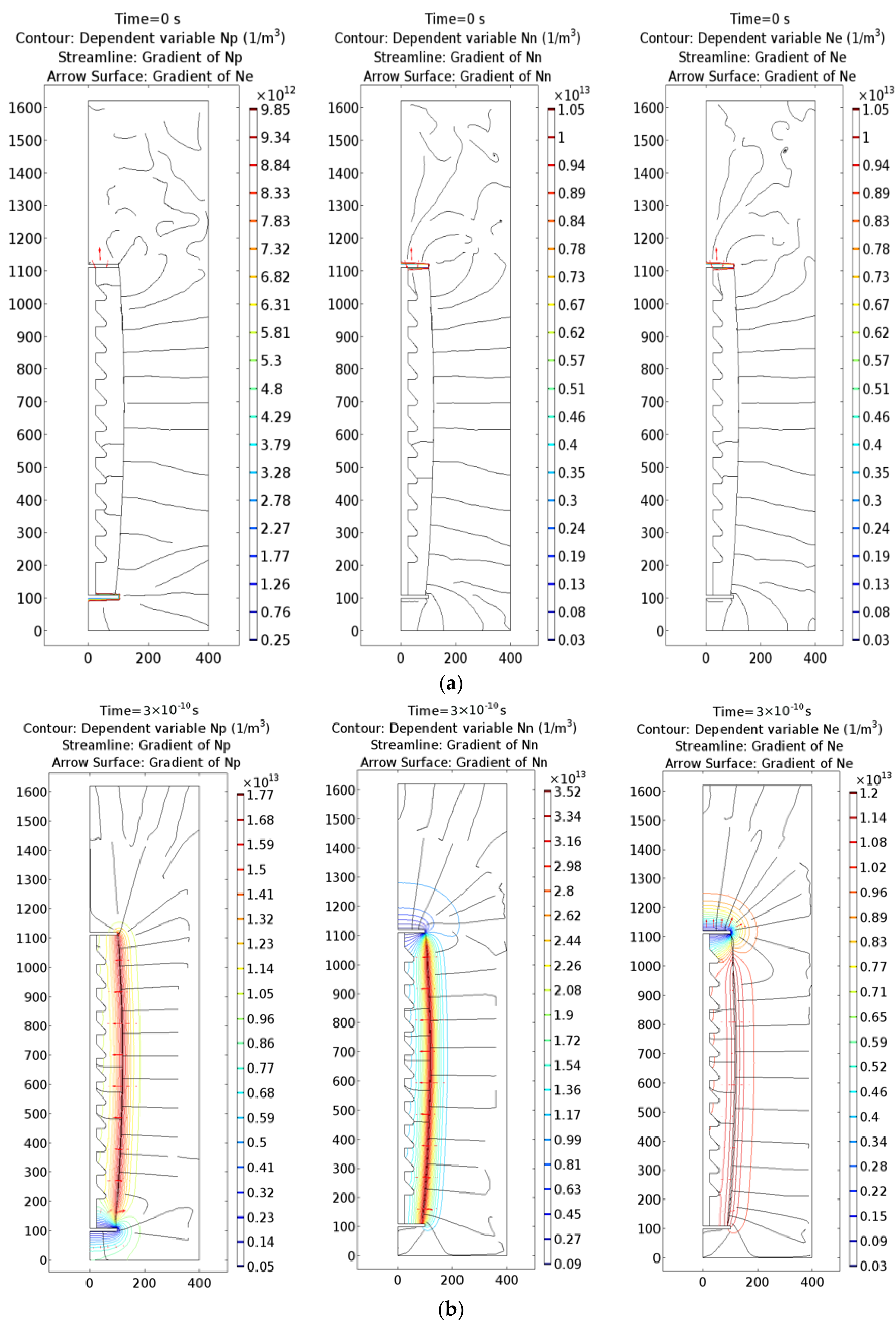
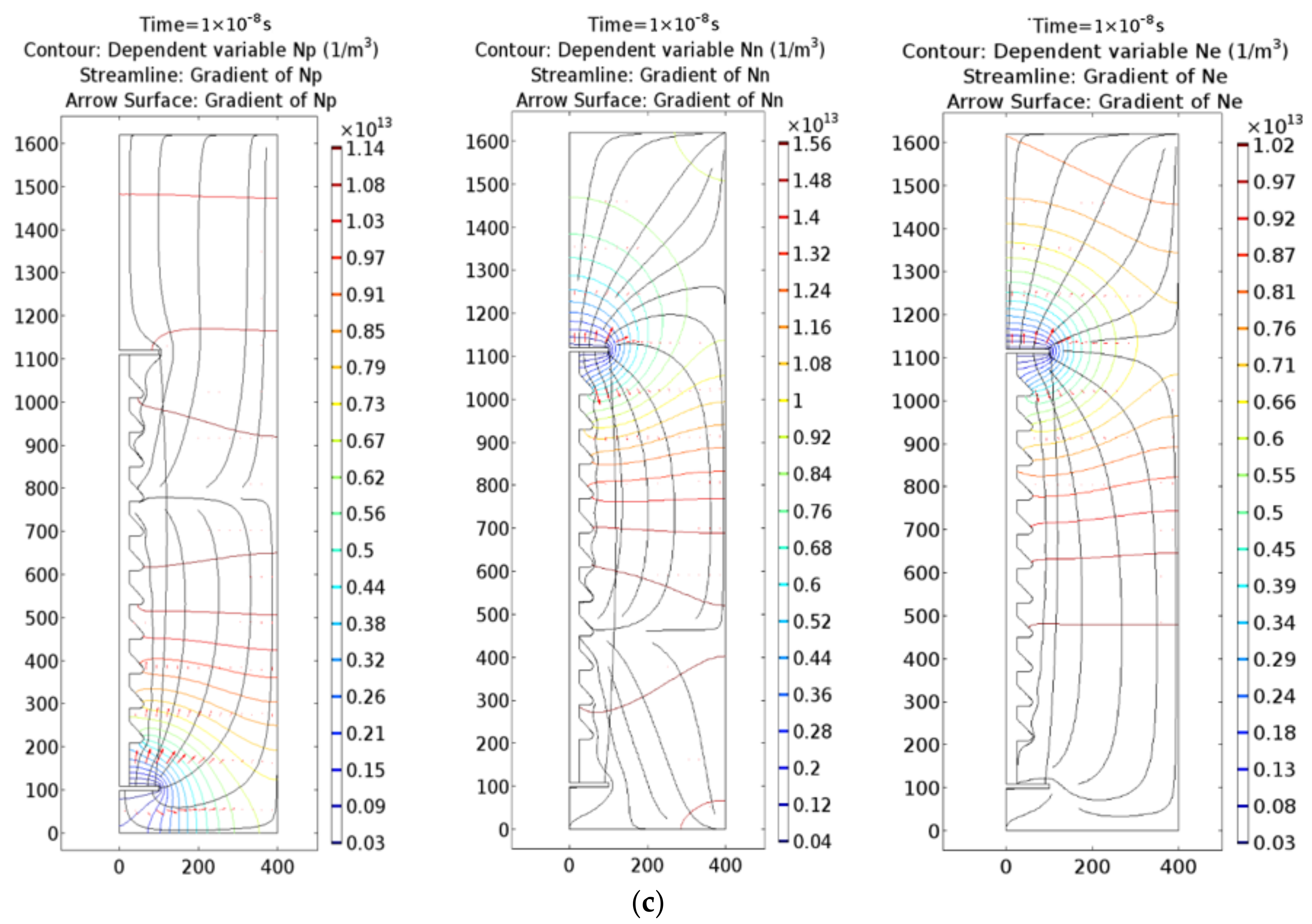
| Name | Expression | Description |
|---|---|---|
| p | 2.0 × 10−4 (m2/V·s) | Positive ion mobility |
| 5.05 × 10−4 (m2/s) | Positive ion diffusivity | |
| n | 2.2 × 10−4 (m2/V·s) | Negative ion mobility |
| 5.56 × 10−4 (m2/s) | Negative ion diffusivity | |
| ep | 5.0 × 10−14 (m3/s) | Electron-positive ion recombination rate |
| pn | 2.07 × 10−13 (m3/s) | Positive-negative particle recombination rate |
| f0 | 1.7 × 109 (1/m3·s) | Source item |
| kdet | 1 × 10−18 (m3/s) | Electron separation rate from negative ions |
| Boundary | Drift Diffusion Ne | Drift Diffusion Np | Drift Diffusion Nn |
|---|---|---|---|
| Symmetry axis | |||
| Upper electrode | =0 | ||
| Lower electrode | =0 | ||
| Arc striking line | |||
| Others |
© 2018 by the authors. Licensee MDPI, Basel, Switzerland. This article is an open access article distributed under the terms and conditions of the Creative Commons Attribution (CC BY) license (http://creativecommons.org/licenses/by/4.0/).
Share and Cite
Cong, H.; Li, Q.; Du, S.; Lu, Y.; Li, J. Space Plasma Distribution Effect of Short-Circuit Arc on Generation of Secondary Arc. Energies 2018, 11, 828. https://doi.org/10.3390/en11040828
Cong H, Li Q, Du S, Lu Y, Li J. Space Plasma Distribution Effect of Short-Circuit Arc on Generation of Secondary Arc. Energies. 2018; 11(4):828. https://doi.org/10.3390/en11040828
Chicago/Turabian StyleCong, Haoxi, Qingmin Li, Shiyue Du, Yangfei Lu, and Jinsong Li. 2018. "Space Plasma Distribution Effect of Short-Circuit Arc on Generation of Secondary Arc" Energies 11, no. 4: 828. https://doi.org/10.3390/en11040828
APA StyleCong, H., Li, Q., Du, S., Lu, Y., & Li, J. (2018). Space Plasma Distribution Effect of Short-Circuit Arc on Generation of Secondary Arc. Energies, 11(4), 828. https://doi.org/10.3390/en11040828






